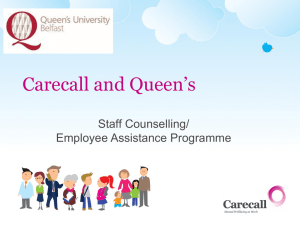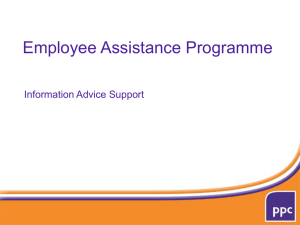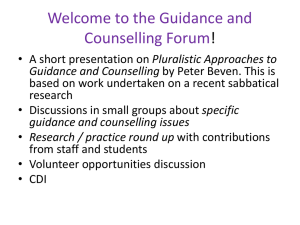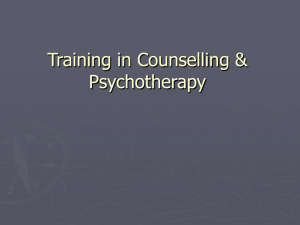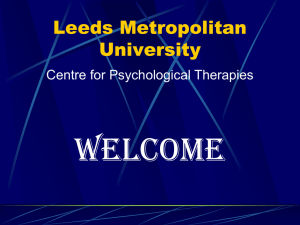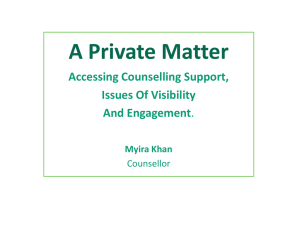Prof Marjatta Vanhalakka
advertisement
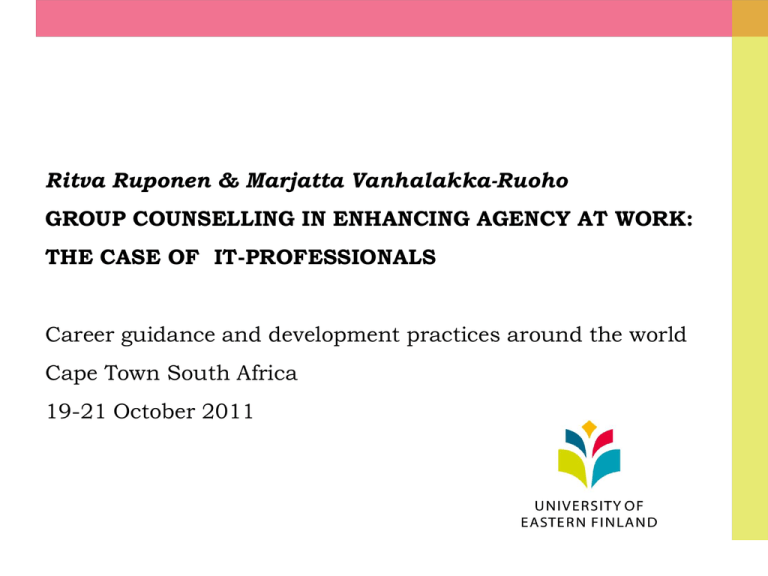
Ritva Ruponen & Marjatta Vanhalakka-Ruoho GROUP COUNSELLING IN ENHANCING AGENCY AT WORK: THE CASE OF IT-PROFESSIONALS Career guidance and development practices around the world Cape Town South Africa 19-21 October 2011 University of Eastern Finland, Joensuu Campus (15,000 degree students – 2,700 staff members – 4 faculties) STARTING POINTS We are developing one methodological approach to evaluate the outcomes of group counselling. This study is part of a more extensive research project entitled ’Group counselling in encountering uncertainty and changes. Navigating forward’ STARTING POINTS Our study is connected with the issues of work place counselling. In this study a group counselling trial was carried out in an IT enterprise. The central model is the structured group counselling model (Borgen et al. 1989). • clearly defined goals • flexible design • a framework promoting learning • a diversity of learning activities. SOME THEORETICAL FRAMES Agency The core essence of agency is seen to be related to the individual’s ability to choose and direct their own actions according to their choices (e.g. Richardson 2004; Gergen 2009). Socio-cultural models stress that the individual’s intentions and desires are not only found in their minds, but they must be understood in a multiplicity of contexts in regard to others and environments. SOME THEORETICAL FRAMES Relationality Life-designing of individuals occurs in relation to and negotiation with significant others both nearby and distant. Individuals are also viewed relationally as acting and connected to the bonds, opportunities and limitations of the cultural and social environment (Schultheiss 2007; Savickas et al. 2010). In work contexts relationality is discussed in many terms: it is a question of joint action, shared expertise and collective action. SOME THEORETICAL FRAMES Dialogicality Human action is understood in interactive relations and the construction of agency is seen as reciprocal. The individual’s action is analyzed as positioned relations to the self, other persons as well as objects and situations, and as the development of these positioned relations (Leiman 2007, 2008). The focus is on • the development of reflective self-observation • movements generated in the subject and object positions (location of agency; being a subject or an object ) The key question: How to evaluate the outcomes of group counselling? RESEARCH DESIGN The research task is to clarify what workers receive both individually and collectively from group counselling for their agency at work. • What incentives has the group counselling trial given the participants to develop their agency at work? • How can these changes be analyzed dialogically as situationally bound and relationally associated processes? RESEARCH DESIGN The goal of the trial was to help the workers recognize their own work methods and develop their strengths and work methods amid changes in and challenges to their competence. Group counselling was effectuated according to the five session and one follow-up (5 + 1) model. Pre-group tasks and intermediate tasks were included in the counselling process. The researchers also served as group counsellors. An example of the design 2nd session Opening of session Joint work chart Zooming in on teamwork chart: chat groups Individual relation to work: pair work Intermediate task for the next session: Mapping my experiences of learning and success Summary of session. Thoughts for next time. RESEARCH DESIGN Participants Half of the enterprise’s personnel participated in the group counselling trial; 12-14 people were present at different sessions. Male-dominated workplace: One female employee present. Methods Email-questionnaire prior to beginning The notes of the counselors and the materials (charts) produced by the participants in the group sessions were collected. The main data were collected by interviews (n=11) some weeks after the last session. RESEARCH DESIGN Analysis of interview data: The subject of the analysis is verbal expressions and relational speech The interview material was analyzed on two levels. • The first stage was a group-level analysis. It examined the changes the participants described in respect to group counselling, teamwork and their own work. • The second level analyzed individual changes. The subject of this analysis was individual self-observations, action patterns and changes in them. A solution to the key question? In this second stage of the analysis some principles of dialogical sequence analysis (DSA) (Leiman & Stiles) are applied to the participants’ self-observations and action patterns and changes in them The distinctive feature is the use of an individualised formulation of the self-observations, action patterns and the recurring positions. Interest focuses on how the experiences from group counselling process are expressed, how self-observation occurs and which subject and object positional moves are observed. Some reservations….. The analysis conditions differ from the original use of DSA in that the materials do not come from the counselling process itself but the participants reflect retrospectively (one month later) on their experiences of group counselling and their significance at work. RESULTS The results from the group level analysis showed e.g. In regard to group counselling Experience of teamwork Opportunity to observe the perspective of others Possibility of open discussion Expressing problems Possibility to voice their own ideas and views Stimulation of new methods of perceiving “the actions of others” but also Handling of joint familiar problems RESULTS But we focus on the results of the second level of analysis: • how the participants reflected on the group counselling process and work processes, • what kind of qualitative changes occurred the in area of selfobservation and • how movements are generated in the subject and object positions., i.e in the location of agency; being a subject or an object RESULTS Three different patterns of changes are presented which are, at the same time, both individual and relational. The descriptions are based on interviews of three key informants. These development courses differ when they are examined from the perspectives of shade of selfobservation, field of self-observation and the location of agency. RESULTS Course of Shade of self- Expansion of Subject/object development observation perspectives position Progressive actively stimulating widening, analytic renewed/reinforced subject position Skeptical Dissociated stimulating and widening, changing subject and skeptical vacillating object position stimulating and widening, disengaging vanishing disappearing RESULTS Progressive H4:41-44: Well probably something like that if you’d try to take others into account more, and also see things from their viewpoints and see the bigger picture too. At least something like that would be a good goal. H4: 127-131. At least people all got something to think from the other people’s viewpoints, which is a good thing, and then they can also identify with the others’ work and can in the future hopefully look at things from a distance, and through that get a different picture of situations. That’s what I hope for and that would remain with the whole group that took part there.. RESULTS Skeptical H6:38-46:Well, there hasn’t really been any improvement seen in these work procedures, more like that I don’t really know, can you really increase team work in certain circumstances at all. Of course if there is some bigger project like this that you take part in and in a situation like that, but I have a lot of projects that I work on my own on, and there is no bigger group that would do the same work, so there hasn’t been any concrete improvements yet. RESULTS Dissociated But to be honest I don’t really know, but this starts from the CEO level, so why hasn’t this been brought up that we should make these responsibilities clearer in different fields of products and then get some sort of clarity in these different projects. Now there are too much different kinds of work at the moment and that’s pretty confusing, and then it came up that people, good useful people, tend to get a bit stressed when there’s always someone pushing you do this and do that and for the sake of this work it should be clearer that certain people take care of certain things, instead of just this running around. DISCUSSION Group counselling enabled the expansion of viewpoints and perspectives created opportunities of sharing widened the possibilities to see “otherness” led to reflective considerations -> These are among the basic group counselling goals DISCUSSION Challenges of group counselling • how to support the progressive processes afterwards • how to deal with the skepticism during the process and afterwards • how to prevent dissociation between the process and the daily life afterwards DISCUSSION Evaluating the outcomes of group counselling: Agency, relationality and dialogicality are promising theoretical tools This was a preliminary ’sketch’, we have to develop our methodological solutions further The depicted courses of development are individual, but at the same time they are relational Outcomes have to be analyzed as meaning-making that is situationally bound and related to individual and collective proximal zones of development. • the participant’s life- and work situation • the everyday work and the character of expert work • the operational culture of the enterprise. References e.g. Borgen, W.A., Pollard D.E., Amundson, N.E. & Westwood, M.J. (1989). Employment groups: the counseling connection. Toronto: Lugus. Gergen, K.J. (2009) Relational being: beyond self and community. New York: Oxford University Press. Leiman, M. (2007). Dialoginen ohjaus ja neuvonta. Julkaisussa Tuetusta toimijuudesta itsenäiseen toimijuuteen. Dialoginen ohjaus ja neuvonta käytännössä. Optio työelämään-projekti,9-27. Leiman, M. (2008). Kognitiivis-analyyttinen näkökulma. Teoksessa S. Kähkönen, I.Karila & N. Holmberg (toim.) Kognitiivinen psykoterapia. Helsinki. Duodecim, 495-509. Leiman, M. & Stiles, W.B. (2001). Dialogical sequence analysis and the zone of proximal development as conceptual enhancements to the assimilation model: The case of Jan revisited. Psychotherapy Research, 11(3), 311-330. Richardson, M.S. (2004). The emergence of new intentions in subjective experience: A social/personal constructionist and relational understanding. Journal of Vocational Behavior, 64, 485-498. Savickas, M., Nota, L., Rossier, J., Dauwalder, J-P., Duarte, M.E., Guichard, J., Soresi, S., Van Esbroeck R. & van Vianen, A.E.M. (2009). Life designing: A paradigm for career construction in the 21st century. Journal of Vocational Behavior 75(3), 239─250. Schultheiss, D.E. (2007). The emergence of a relational cultural paradigm for vocational psychology. Journal for Educational and Vocational Guidance 7(3), 145─147. Thank You for your attention! Email: marjatta.vanhalakka-ruoho@uef.fi
